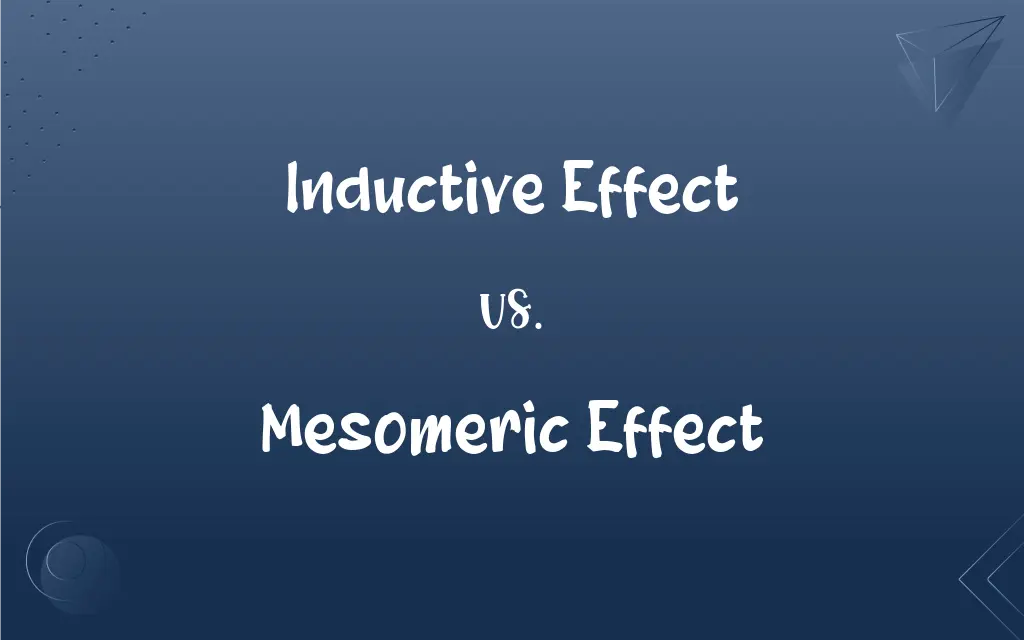Inductive Effect vs. Mesomeric Effect: What's the Difference?
Edited by Aimie Carlson || By Harlon Moss || Published on March 22, 2024
The inductive effect involves electron shifting along a chain of atoms due to electronegativity differences, while the mesomeric effect involves electron delocalization over adjacent atoms.

Key Differences
The inductive effect and mesomeric effect are two fundamental concepts in organic chemistry, describing different ways electrons are distributed in molecules. The inductive effect is a permanent state of polarization caused by the electronegativity differences between atoms. In contrast, the mesomeric effect involves the delocalization of electrons across a molecule through π orbitals. This effect is observed in systems containing conjugated double bonds or lone pairs that can be delocalized.
The inductive effect is a result of the difference in electronegativity leading to a permanent polarization, the mesomeric effect arises from the structural arrangement of molecules allowing electron delocalization. The inductive effect tends to influence the molecule's physical properties, such as boiling points and solubility, whereas the mesomeric effect plays a crucial role in determining the chemical properties and reactivity patterns of compounds.
Both the inductive and mesomeric effects are essential for understanding the behavior of organic compounds. The inductive effect can stabilize or destabilize ions and radicals by dispersing charge through sigma bonds. Meanwhile, the mesomeric effect stabilizes structures by allowing electrons to move freely over a larger structure, reducing energy and increasing stability. These effects are critical in mechanisms such as nucleophilic substitutions and electrophilic additions.
The inductive effect and mesomeric effect describe electron distribution in molecules but differ in their origins and consequences. The inductive effect is about shifting electron density due to electronegativity differences, affecting the molecule's polarity. The mesomeric effect, however, involves electron delocalization that stabilizes molecules and influences their chemical reactivity, showcasing the complexity of organic chemistry.
Comparison Chart
Nature of Effect
Electronegativity-driven electron shifting through σ bonds.
Electron delocalization through π bonds or lone pairs.
ADVERTISEMENT
Impact on Molecule
Creates permanent polarization; affects physical properties.
Stabilizes molecules; influences chemical reactivity.
Distance Dependency
Decreases with distance; significant near the electronegative atom.
Not distance-dependent; relies on structural arrangement.
Role in Stability
Can stabilize or destabilize ions and radicals.
Generally stabilizes molecules by electron delocalization.
Influence on Reactivity
Affects reactivity through polarity changes.
Alters reactivity by providing resonance structures.
Inductive Effect and Mesomeric Effect Definitions
Inductive Effect
Effectiveness decreases with increasing distance from the source.
The inductive effect of a fluorine atom weakens significantly three carbons away.
ADVERTISEMENT
Mesomeric Effect
Provides stability through resonance structures.
The mesomeric effect is responsible for the nucleophilicity of phenoxide ions.
Inductive Effect
Stronger in atoms with higher electronegativity.
The presence of a nitro group significantly increases the inductive withdrawal of electrons.
Mesomeric Effect
Enhances aromatic stability through delocalization.
The mesomeric effect explains the exceptional stability of aromatic compounds.
Inductive Effect
Affects acidity and basicity of compounds.
The inductive effect of alkyl groups decreases the acidity of carboxylic acids.
Mesomeric Effect
Requires conjugated systems or lone pairs for electron movement.
The mesomeric effect is evident in the color of conjugated dyes.
Inductive Effect
Electron density shifts towards more electronegative atoms.
The inductive effect increases the acidity of haloacids.
Mesomeric Effect
Electrons are distributed over adjacent atoms.
The mesomeric effect contributes to the stability of benzene.
Inductive Effect
Creates a permanent dipole in the molecule.
The inductive effect is responsible for the higher boiling point of chloroethane compared to ethane.
Mesomeric Effect
Alters electrophilic and nucleophilic attack sites.
The mesomeric effect makes the ortho and para positions more reactive in substituted benzenes.
FAQs
What defines the inductive effect?
Electron shifting due to electronegativity differences.
Is the mesomeric effect distance-dependent?
No, it depends on the molecule's structural arrangement.
Are there exceptions to the inductive effect's influence?
Its influence is consistent but varies in magnitude.
Can the inductive effect stabilize radicals?
Yes, by dispersing the charge.
Does the mesomeric effect impact chemical reactivity?
Yes, by providing alternative resonance structures.
What is the mesomeric effect?
Electron delocalization in molecules with π bonds or lone pairs.
How does distance affect the inductive effect?
It decreases with distance from the electronegative atom.
What role does electronegativity play in the inductive effect?
Higher electronegativity increases the effect.
Does the mesomeric effect apply to all organic molecules?
Only to those with suitable conjugation or lone pairs.
How do substituents affect the inductive effect?
Electron-withdrawing or donating groups modulate its strength.
How does the mesomeric effect influence molecule stability?
It stabilizes molecules through electron delocalization.
Can the inductive effect affect a molecule's boiling point?
Yes, by altering its polarity.
How does conjugation relate to the mesomeric effect?
Conjugation allows for the effective delocalization of electrons.
Can the inductive effect predict reactivity patterns?
Yes, especially in polarized molecules.
Is the inductive effect relevant in acid-base chemistry?
Yes, it significantly influences acidity and basicity.
How is the mesomeric effect observed in aromatic compounds?
Through enhanced stability and reactivity patterns.
How do chemists utilize knowledge of these effects?
To predict and explain reactivity, stability, and molecular properties.
What types of compounds exhibit a strong mesomeric effect?
Aromatic compounds and conjugated systems.
What is a key difference in how the inductive and mesomeric effects operate?
The inductive effect relies on σ bonds, while the mesomeric uses π bonds or lone pairs.
Are the inductive and mesomeric effects ever competing?
They can interact complexly, complementing or competing depending on the molecular context.
About Author
Written by
Harlon MossHarlon is a seasoned quality moderator and accomplished content writer for Difference Wiki. An alumnus of the prestigious University of California, he earned his degree in Computer Science. Leveraging his academic background, Harlon brings a meticulous and informed perspective to his work, ensuring content accuracy and excellence.
Edited by
Aimie CarlsonAimie Carlson, holding a master's degree in English literature, is a fervent English language enthusiast. She lends her writing talents to Difference Wiki, a prominent website that specializes in comparisons, offering readers insightful analyses that both captivate and inform.
































































